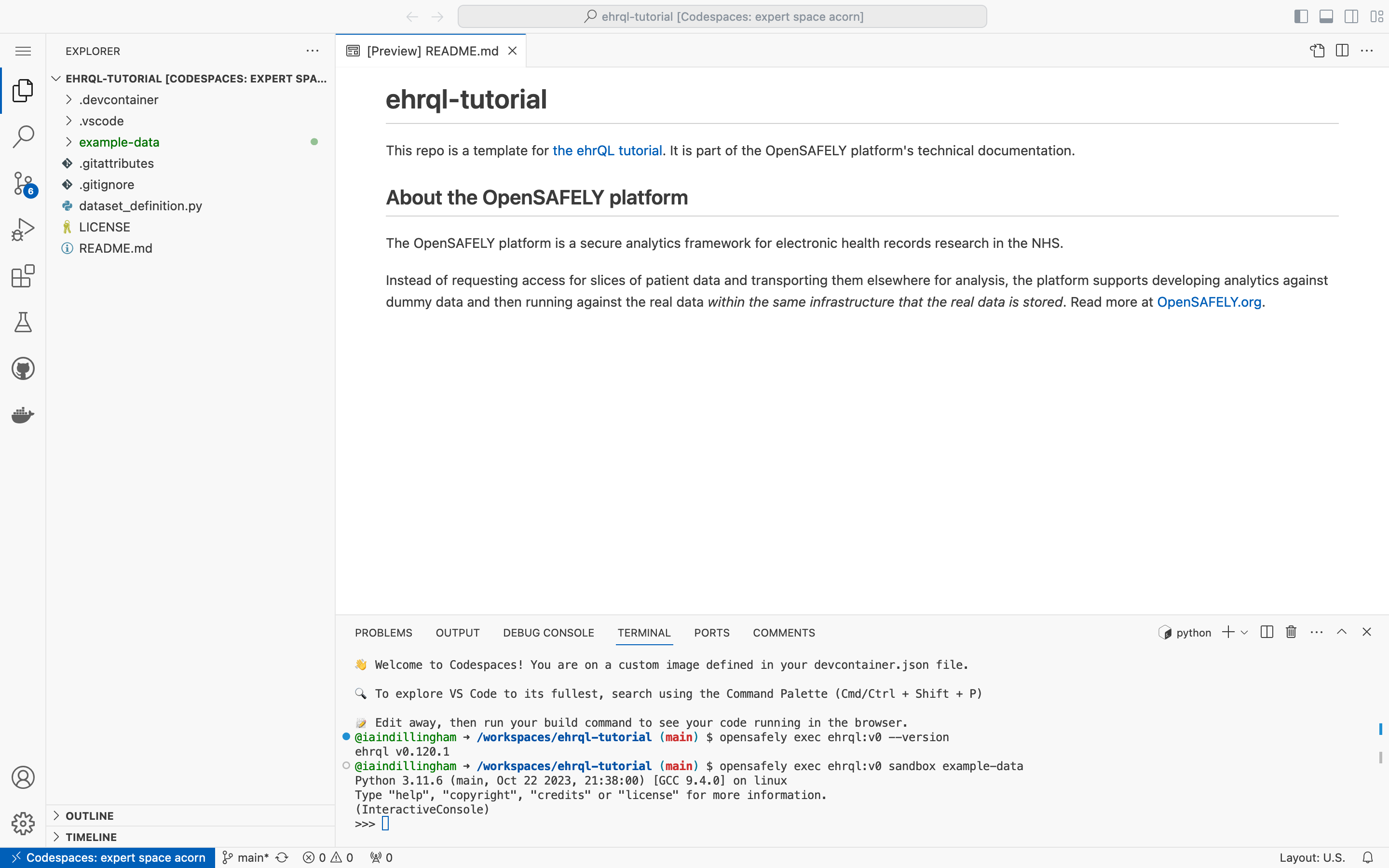Working with tables
In this section, you will work with tables in the sandbox. The sandbox is an environment for experimenting with ehrQL that contains a small amount of dummy data.
Start the sandbox🔗
In the terminal, type
opensafely exec ehrql:v1 sandbox example-data
and press Enter.

Notice that the command prompt,
or the set of characters before the cursor,
has changed to >>>.
For the remainder of this section,
when you see >>>,
you should type the code that follows into the sandbox and press Enter.
Work with patient data🔗
In most cases, there is one source of patient data: the patients table.
To work with the patients table,
first import it into the sandbox.
>>> from ehrql.tables.core import patients
Importing tables into the sandbox
Importing a table into the sandbox doesn't display any output. In other words, typing
>>> from ehrql.tables.core import patients
into the sandbox and pressing Enter displays
>>>
The patients table has one row per patient.
Notice that all values in the patient_id column are unique.
>>> patients
patient_id | date_of_birth | sex | date_of_death
------------------+-------------------+-------------------+------------------
1 | 1973-07-01 | female | 2015-09-14
2 | 1948-03-01 | male | None
3 | 2003-04-01 | male | None
4 | 2007-06-01 | female | None
5 | 1938-10-01 | male | 2018-05-23
6 | 1994-04-01 | female | None
7 | 1953-05-01 | male | None
8 | 1992-08-01 | female | None
9 | 1931-10-01 | female | 2017-11-10
10 | 1979-04-01 | male | None
Similarly, the patients.date_of_birth column has one row per patient.
(If a table has one row per patient, then a column from the table must also have one row per patient.)
Notice that the column is indexed by patient_id.
>>> patients.date_of_birth
1 | 1973-07-01
2 | 1948-03-01
3 | 2003-04-01
4 | 2007-06-01
5 | 1938-10-01
6 | 1994-04-01
7 | 1953-05-01
8 | 1992-08-01
9 | 1931-10-01
10 | 1979-04-01
Work with event data🔗
Unlike patient data, there are many sources of event data:
the medications table, for example.
To work with the medications table,
first import it into the sandbox.
>>> from ehrql.tables.core import medications
The medications table has many rows per patient.
Notice that some values in the patient_id column are not unique,
but that all values in the row_id column are unique.
>>> medications
patient_id | row_id | date | dmd_code
------------------+-------------------+-------------------+------------------
1 | 1 | 2014-01-11 | 39113611000001102
2 | 2 | 2015-08-06 | 39113611000001102
2 | 3 | 2018-09-21 | 39113311000001107
2 | 4 | 2020-05-17 | 22777311000001105
4 | 5 | 2022-11-09 | 22777311000001105
5 | 6 | 2017-05-11 | 39113611000001102
6 | 7 | 2017-07-11 | 3484711000001105
6 | 8 | 2019-07-06 | 39113611000001102
8 | 9 | 2021-01-27 | 3484711000001105
10 | 10 | 2015-03-14 | 3484711000001105
Similarly, the medications.date column has many rows per patient.
Notice that the column is indexed by patient_id and row_id.
>>> medications.date
1 | 1 | 2014-01-11
2 | 2 | 2015-08-06
2 | 3 | 2018-09-21
2 | 4 | 2020-05-17
4 | 5 | 2022-11-09
5 | 6 | 2017-05-11
6 | 7 | 2017-07-11
6 | 8 | 2019-07-06
8 | 9 | 2021-01-27
10 | 10 | 2015-03-14
Transform tables into a dataset🔗
Your task, as a researcher, is to transform tables
— such as patients and medications —
into a dataset that is suitable for analysis.
Tables and datasets
In ehrQL, tables and datasets perform different functions. Whilst both can be represented as rows and columns, a dataset is a group of patients with common statistical characteristics. In other words, a dataset is a cohort.
Transform event data into patient data🔗
To transform event data into patient data:
- Sort the event data
- Select either the first row or the last row of the event data
>>> medications.sort_by(medications.date).first_for_patient()
patient_id | date | dmd_code
------------------+-------------------+------------------
1 | 2014-01-11 | 39113611000001102
2 | 2015-08-06 | 39113611000001102
4 | 2022-11-09 | 22777311000001105
5 | 2017-05-11 | 39113611000001102
6 | 2017-07-11 | 3484711000001105
8 | 2021-01-27 | 3484711000001105
10 | 2015-03-14 | 3484711000001105
Filter event data🔗
To filter event data, select rows that match or do not match a condition.
Rows that match 100mcg/dose Salbutamol:
>>> medications.where(medications.dmd_code == "39113611000001102")
patient_id | row_id | date | dmd_code
------------------+-------------------+-------------------+------------------
1 | 1 | 2014-01-11 | 39113611000001102
2 | 2 | 2015-08-06 | 39113611000001102
5 | 6 | 2017-05-11 | 39113611000001102
6 | 8 | 2019-07-06 | 39113611000001102
Rows that do not match 100mcg/dose Salbutamol:
>>> medications.except_where(medications.dmd_code == "39113611000001102")
patient_id | row_id | date | dmd_code
------------------+-------------------+-------------------+------------------
2 | 3 | 2018-09-21 | 39113311000001107
2 | 4 | 2020-05-17 | 22777311000001105
4 | 5 | 2022-11-09 | 22777311000001105
6 | 7 | 2017-07-11 | 3484711000001105
8 | 9 | 2021-01-27 | 3484711000001105
10 | 10 | 2015-03-14 | 3484711000001105
Extract a column of years from a column of dates🔗
To extract a column of years from a column of dates,
append .year to the column of dates.
>>> patients.date_of_birth.year
1 | 1973
2 | 1948
3 | 2003
4 | 2007
5 | 1938
6 | 1994
7 | 1953
8 | 1992
9 | 1931
10 | 1979
Add one or more years to a column of dates🔗
To add one or more years to a column of dates,
use the years function.
>>> from ehrql import years
>>> medications.date + years(1)
1 | 1 | 2015-01-11
2 | 2 | 2016-08-06
2 | 3 | 2019-09-21
2 | 4 | 2021-05-17
4 | 5 | 2023-11-09
5 | 6 | 2018-05-11
6 | 7 | 2018-07-11
6 | 8 | 2020-07-06
8 | 9 | 2022-01-27
10 | 10 | 2016-03-14